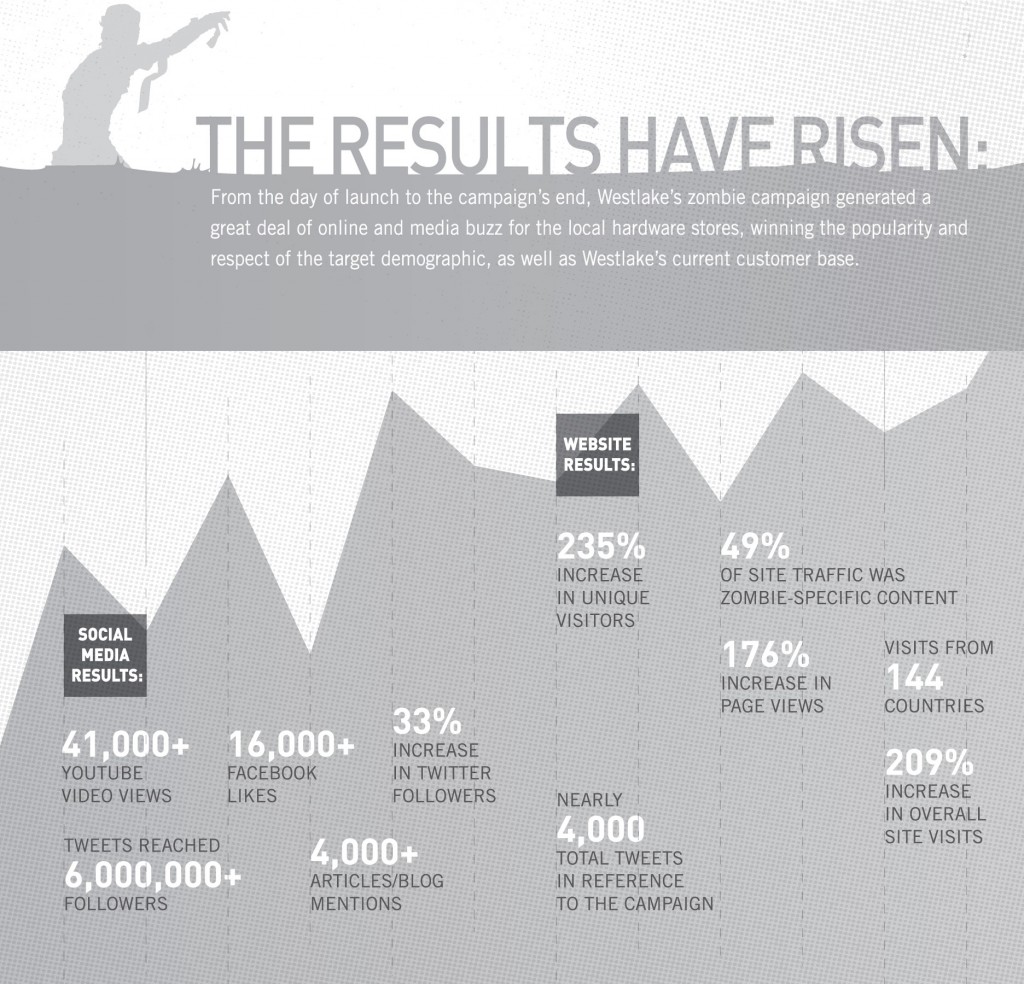April 11th, 2012
Success Starts with Your Address
Using Google Places to increase your organic search.
Google has made dramatic changes to its search algorithm over the past two years. Part of this change has been the integration of Google Places—a free business listing service that displays brick and mortar businesses in both Web and Google Maps searches. And unless you’ve just opened your doors, your company probably already has a Google Places listing.
These recent algorithmic changes have forced many business owners to pay more attention to their Google Places listings—especially if they service local customers. 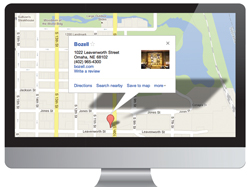 The good news is that optimizing your Google Places listing isn’t very difficult. If you simply implement the following techniques, you increase your chances of displaying higher in Google search for both your business and category. In other words, you will be putting yourself in a position to succeed.
The good news is that optimizing your Google Places listing isn’t very difficult. If you simply implement the following techniques, you increase your chances of displaying higher in Google search for both your business and category. In other words, you will be putting yourself in a position to succeed.
Add your company address to your Google Places account
This may sound obvious, but it is very important that your company’s complete address be included. This will ensure accuracy when Google compares this listing with others that exist on the Web.
Ask your customers and partners to write reviews on your listing
Reviews have been proven to have a direct effect on listing rankings. It is also important to ask them to review your company on other business listing sites within your particular industry, as well.
Add photos and videos
These can help to reinforce the legitimacy of your listing and help prospects better understand your business offerings. You can upload up to 10 images through the Google Places editing interface. You can also add videos by first uploading them to YouTube and then adding the video URL through the Google Places editing interface.
Use important keywords in your business description
If you have been doing any pro-active search engine optimization, you will already have a priority keyword list. Implement these words into your listing. If you don’t currently have a keyword list, then think about which industry terms people are most likely to search for when looking for your business or category. If you want to establish some keywords but aren’t sure where to start, you can use the Google Traffic Estimator.
Get your company listed in other top local directories
By having numerous listings across multiple online directories, you increase the odds of Google picking up your business and website. Some of the most important are Yelp, Bing Business Portal, Yahoo Local, Best of the Web, Hotfrog, YP.com and Foursquare.
Try to get your listing score as close to 100% complete as possible
There is a certain amount of content within your listing that is deemed necessary. These are things like name, address, phone number and categories. The additional types of content, such as videos and additional keywords, will add to your quality score. While your listing will still display even if your score is lower, think of the complete score as a way to improve your listing.
We all know how important it is to be present when a customer or prospect is searching for a solution. The techniques outlined here should help you to effectively compete in organic search. If you have made the recommended changes and are still having problems ranking for the priority keywords you have identified, simply make some tweaks to your listing and watch for changes. In many ways, listing optimization is as much an art as it is a science. Best of luck with your online optimization and future business success.
April 11th, 2012
Website Spring Cleaning
Four simple steps to keeping your website fresh.
It’s easy to get busy with everyday work and put off things you need to do for your own business. One that often gets postponed is making regular updates to your company’s website. In the spirit of spring cleaning, take a look at your site and consider some of the things you can do to spruce the place up a bit. Then head into the rest of the year with your website looking and working better than before.

Whether you have a small marketing site or a full-fledged, enterprise-level web presence, you’re bound to know what parts of your site can and should be updated regularly. Spend some time clicking through the site to see if those key areas have current information.
To get started, you can:
- Audit the site for content that has changed, like personnel, contact information, locations and service offerings.
- Consider what new information hasn’t been added to the site yet.
- Remove out-of-date information that is no longer accurate.

The “technical” side of owning a website shouldn’t be too daunting to the average website owner. There are three things that are easy to check up on in order to make sure your site visitors are having a good experience.
- Run a link checker on your site to identify broken links within your site, and to identify dead links in places where you’ve linked to external content.
- Take a look at where you’ve referenced social media and/or sharing services from your site. Verify that you’re linking to the right accounts and pages.
- Open your site in different web browsers. Most modern browsers update themselves continuously, so you should always be aware of how your site is performing in them.

When’s the last time you looked at your site traffic reports and website analytics? Do you know how many people visit your site on a regular basis? What pages are most popular? These are important insights to understand if you want to get the most out of your website. Here’s what you can do:
- Review your site traffic reports or analytics package. Google Analytics is an excellent—and free—tool to use for this purpose. Tools like this allow you understand conversion rates on things like landing pages, e-commerce transactions and email signups, helping you identify where to focus your efforts for better results.
- Look at which search engines have referred people to your site and what search terms they are using. If you’re getting a lot of traffic for terms that don’t lead to increased business for you, then it may be time to look at your comprehensive SEO strategy.
- Perform a search via Google, Bing and Yahoo for your business name, address, locations and other “local” search criteria. Make sure your site’s information matches what’s in popular online local business listings and services.

Take a step back and evaluate the big picture. Without taking the time to assess whether your business strategy still lines up with your marketing and web strategy, you could be missing out on key opportunities and new resources. To begin:
- Evaluate whether the site’s purpose is still on track. Does your site’s purpose and functionality align with your marketing and business goals? What could be improved?
- Consider what you perceive is working well and what’s not. What have you learned over time that would help you make better choices?
- Factor in external feedback and how you can use this to improve your visitors’ experiences.
By taking a little bit of time, even if it’s only once per year during spring cleaning, you can help ensure that your website is looking good and helping your business.
April 11th, 2012
Your customers called. They’re going mobile.
What does mobile shopping mean for your business?
After last year’s holiday season, there is a dizzying number of statistics surrounding mobile shopping, and several new ways of thinking have come to light. To put it simply: mobile is becoming the new online. It’s already been proven that consumers use a number of sources to access information, and, when making a purchase, more than 30 percent are influenced by multiple “channels,” such as print, TV and online. But mobile shopping is growing.
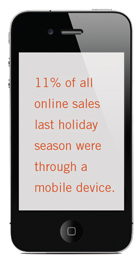 Eleven percent of all online sales last holiday season were through a mobile device, doubling from December 2010 to December 2011. This recent shopping behavior insists that all retailers incorporate mobile into their toolboxes, or face being minimized or removed from consideration sets.
Eleven percent of all online sales last holiday season were through a mobile device, doubling from December 2010 to December 2011. This recent shopping behavior insists that all retailers incorporate mobile into their toolboxes, or face being minimized or removed from consideration sets.
As smartphone ownership numbers continue to rise, especially among younger users, more and more people are implementing Web on the go, changing how they access information.
Reinforcing the shift, 15 percent of all shoppers, and 38 percent of Web shoppers, have used their mobile phones to access a retail website, mobile site or mobile app. Also, 34 percent of online shoppers do product research from their phones, resulting in almost half of them purchasing the product right then and there. What may surprise you, though, is what’s happening in your store.
For many mobile users, smartphones are helping them shop smarter. Among smartphone owners, approximately 84 percent say they have used their phones in-store to enhance their experiences. They’ve partaken in actions such as in-aisle price comparison, reading product reviews, visiting the store’s mobile site, sharing findings on social media, and scanning a QR code. All factors that can persuade a purchase.
Also important to note is that 43 percent of these smartphone owners said they’ve used their mobile devices in-store to check out the competitor. They’ve visited a competitor’s website, bought a competitor’s product, and even decided to visit a competitor’s store or website to make a purchase.
Thanks to mobile, just because a customer is in your store, that does not mean you’re guaranteed a sale. Competitors now have the opportunity to deliver a more enticing price or experience before a purchase is even made. So strategies need to be in place to retain your in-store mobile shoppers.
First and foremost, establish whether or not a mobile Web page or application makes sense for your brand and customers. Providing a positive mobile space for customers to learn about your business and products will most often help make their shopping experiences better, as well as give your company more credibility.
Secondly, consider your competitors and try to compete with them in one of two ways:
- Beat them with your prices.
Price is a big motivator when it comes to customers going with your competitor instead of you. Try offering price-matching or other incentives, or deliver coupons upon mobile check-in. Consider gifting these offers in return for input that you can use later to enhance their mobile experiences.- Beat them with your customer service.
Ensure that the in-store experience for customers is stellar. Many people check reviews while in your store, so make sure that the reviews they’re reading are positive. If enough reviews complement your products/services, you have a better chance of making the sale, even if your prices are a little higher. Work with your sales people to ensure customer service is always top-notch.
Who is doing all this research? Foresee, Cisco, IBM, White Horse, and Prosper Mobile Insights have all shared research on mobile shoppers that influenced this article.
April 11th, 2012
A campaign 154 years in the making
Behind the scenes of First National Bank’s latest campaign
How it all began.
To say it started in some brainstorming session would be an understatement. Truth is, this campaign started when Herman Kountze flipped the “open” sign in 1857. You see, Kountze started a bank to help the upstart city of Omaha during an economic depression. Since the moment the doors opened, the founders of First National Bank wanted to help make their community a more prosperous place to live and do business. That sense of community pride and goodwill has lasted all the way to today.
Flash to 2011. The national economy was in a deep recession. People were out of jobs and losing their homes, while banks across the country were closing their doors.
This was no time to sell a checking account or a mortgage loan. This was a time to reinforce First National Bank’s role in the community. A time to reconnect with customers as neighbors, not numbers. A time to say “we’ve been there for you before; we’re here for you now.”
Then came the brainstorming session. The goal was clear: Bozell and First National Bank wanted to create a campaign that not only translated the stability of the bank, but also illustrated the pride they have in their community and the customers they serve. But we didn’t want the bank to BE the story; we wanted to tell how First National Bank was a PART of the story of Omaha.
There was one thing First National Bank could say that no other bank could. One message that told the story of their history, as well as their commitment to their community.
This is Omaha. And we’re proud to have been born and raised here.
 The scripts.
The scripts.
The words for this campaign couldn’t be written in an hour. They had to unite a city. They had to tell a story. They had to inspire. Great care was taken to write a narrative that 800,000 people would understand and believe in. In total, five scripts were written. Each narrative focused on an aspect of Omaha’s community pride – sports, music, business and more.
The visuals.
To create the type of spots that would evoke strong emotion, the visuals needed to speak just as loudly and be just as dramatic as the script. The goal of these spots was to tell a story, not sell a product. So the ultimate goal was to have the spots look like a documentary, as opposed to a commercial.
The production.
After an extensive search for directors and production companies, we found the perfect match in director Phil Brown of Mighty Films. Not only did Phil have a great documentary style, but he wasn’t from Omaha. Having an outsider’s point of view would create a much more unexpected visual story. His eye for Omaha turned over stones that most locals had never seen before.
In total, production took almost three months. Only two weeks were devoted to the actual shooting of the footage, while more than two months were spent on editing and music. But when it was all said and done, Bozell and First National Bank had created an award-winning campaign that received a great response from the people of Omaha.
To view the First National Bank “Born & Raised” TV spots, click here.
“The best campaign the bank has ever done.” – Dan O’Neill, President, First National Bank
April 11th, 2012
The Not-So-Sweet Tweet
Recovering from social media blunders
Social media is legendary for its speed and transparency, but that also means your mistakes can spread like wildfire. Anyone managing more than one social profile or using a third-party client like TweetDeck or HootSuite has felt their stomach lurch when they think they accidentally posted something personal on the wrong account.
If a mistake happens, being upfront in dealing with the clean up, handling it quickly, honestly and with humility, is a good way to start recovering.
One of the best examples I’ve seen is how the Red Cross handled a mistake made by one of their staffers who tweeted on the wrong account. It was certainly a cringe-worthy moment when this tweet went out:

But instead of blowing the tweet out of proportion, the Red Cross responded very quickly with this tweet:

The Red Cross didn’t panic. They responded with a bit of humor while acknowledging the mistake immediately. They apologized and even got in a message about driving safely.
That tweet turned into an opportunity for Red Cross when Dogfish Head jumped on the hashtag and asked Dogfish Head fans to donate to the Red Cross, providing a link and using the hashtag #gettngslizzerd.
If a mistake happens, apologize. Don’t try to justify. And be very honest in your response.
Six keys to a great apology.
- Address the issue quickly. Silence is not an option.
- Even if it is not directly your fault, apologize for it anyway.
- Intent matters; people are more likely to forgive an honest mistake.
- Identify the steps that are being (or will be) taken to fix the problem.
- Pick the right medium for you to be most effective. A well-written apology trumps a badly delivered video message.
- Continuously monitor all social and non-social channels so you can continue to address the issue further, if needed.
At the end of the day, remember: you’re only human. The world will not end because of a less-than-perfect social media message. With a little humor, and a bit of bravery, your mistake could reveal a more human side to your brand – and lead to more sales.

Social media blunders run the gamut. There are harmless ones, like accidentally posting a funny video on the wrong account. But there are also slips that can do some damage. Of these, there are largely five main types:
 Inappropriate opinion – when you react to something that you should have thought out a little better.
Inappropriate opinion – when you react to something that you should have thought out a little better.
The insensitive statement – this can cause serious damage to a brand, particularly when it’s about a tragic current event.
Kenneth Cole’s tweet, following the protests in Egypt’s Tahrir Square,
Square,  resulted in negative PR for the brand:
resulted in negative PR for the brand:
This got Gottfried fired as spokesperson for Aflac:
The early release– when something is mistakenly announced too early.
 The New York Giants official website accidentally announced the winner of Super Bowl XLVI more than 24 hours before Sunday’s big game:
The New York Giants official website accidentally announced the winner of Super Bowl XLVI more than 24 hours before Sunday’s big game:
 The false reward –offering a deal or prize you can’t deliver. For example, several Canadian companies recently got in trouble when they couldn’t honor the deals from group-buying sites.
The false reward –offering a deal or prize you can’t deliver. For example, several Canadian companies recently got in trouble when they couldn’t honor the deals from group-buying sites.
The hack – when someone breaks into your account. This is both the most dangerous and the easiest to recover  from. Just make sure you look at your security to prevent it from happening again.
from. Just make sure you look at your security to prevent it from happening again.
 Fox News was hacked on July 4, 2011:
Fox News was hacked on July 4, 2011:
December 29th, 2011
Keeping up with the @Kardashians
Judging people based on possessions is something we, as a society, just do. No, it’s not right, and there are a lot of directions we can point the blame. We are constantly bombarded by flashy reality television shows flaunting über fancy “cribs” and cars. We’re told through advertising that if we don’t have the latest iPhone, iPad and matching Mac Book Pro … well, then, “you’re just not with it.” But it’s not just in the media. We see it when we watch our neighbors fawn over what the other neighbors are driving. We watch our friends look at the ring size as soon as a friend gets engaged. As a culture, we’ve always been concerned with “the haves.”
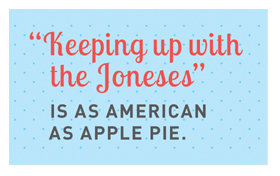 But, over the last few years, as social media becomes a bigger part of our culture and lives, a shift has occurred in how we view status symbols. There’s a new dimension to which we are supposed to be paying attention. On top of status being based on worldly possessions, we’re now judging people based on virtual followings. Kim Kardashian, for example, is rarely mentioned in the tabloid magazines without including that she has 11.5 million Twitter followers. She is looked at as more of a legitimate celebrity now, simply for having a massive online following.
But, over the last few years, as social media becomes a bigger part of our culture and lives, a shift has occurred in how we view status symbols. There’s a new dimension to which we are supposed to be paying attention. On top of status being based on worldly possessions, we’re now judging people based on virtual followings. Kim Kardashian, for example, is rarely mentioned in the tabloid magazines without including that she has 11.5 million Twitter followers. She is looked at as more of a legitimate celebrity now, simply for having a massive online following.
This new status measurement is also used with digital marketers and brands. Twitter followers, Facebook fans, and something called a Klout score are used as a quick barometer for how competent individuals are and how well businesses are doing. Marketers are the first to jump for excitement when they reach a high number of Facebook fans, as if they’ve achieved validation for success. Social media blogs write stories about what brands have the most fans and followers. We seem to have replaced “keeping up with the Joneses” with “keeping up with the @kardashians.” And the culprit responsible is what we call vanity metrics.
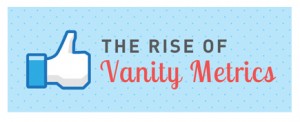 There is a certain segment of social media metrics that we often use as a measurement of businesses’ success. These metrics are called vanity metrics, and marketers are hypnotized by them. Vanity metrics are numbers that most marketers focus on because they look great in press releases, but they don’t necessarily affect overall marketing or business goals.
There is a certain segment of social media metrics that we often use as a measurement of businesses’ success. These metrics are called vanity metrics, and marketers are hypnotized by them. Vanity metrics are numbers that most marketers focus on because they look great in press releases, but they don’t necessarily affect overall marketing or business goals.
The term vanity metrics was coined by Eric Ries and made popular by his book, The Lean Startup. They are defined as numbers that might make you feel good, but they don’t offer clear guidance for what your business should or should not do in the future. Vanity metrics are all the rage for social media marketers. Their intense focus is a big reason why social media ROI is difficult for most brands to judge. Vanity metrics do not necessarily correlate with other measurable numbers that really do matter for your business. These growth metrics can often be signs of traction (which is why they should be monitored), but it is important to distinguish between these vanity metrics and real digital metrics, like conversation rates.
A brand with a huge online following can be less successful than a smaller following of passionate and raving customers. If the executive team asks you how the digital marketing initiatives are going and your only success measurement is a Facebook fan count, you had better hope that the conversation doesn’t dive any deeper. Follower counts alone do not help to evaluate whether or not your strategy is working. They are no indication that your competition is doing better or worse than you. These metrics should be watched, but you should not to be fooled by them.
Moral of the story is to not get swept up in the hype of who has more. Businesses would be wise to quit trying to keep up with the @kardashians and, instead, focus on keeping up with the strategy.
December 29th, 2011
Going Postal.
Direct mail and the changing US Postal Service.
You’ve probably noticed that your mailbox isn’t quite as full as it used to be. First class mail volumes (historically the most profitable segment for the U.S. Postal Service) have fallen at a staggering rate as many previously printed forms of business and personal communications have gone digital.
Printed direct mail volumes have fallen over the past several years, as well, as many direct marketing efforts have moved online. That being said, many marketers still find printed direct mail to be a useful component of an integrated marketing plan. Financial services, publishing, mobile telephone and cable/satellite television providers remain large users of direct mail. As a group, the largest direct mail user perennially is the nonprofit sector. And many luxury merchandise providers continue to count on direct mail to deliver printed catalogs, brochures and invitations, as their target markets have been slower to adopt electronic alternatives.
As the drop in mail volume has financially strapped the Postal Service, several proposals have been put forth, including reducing the Postal Service workforce, eliminating Saturday delivery (or more) and closing facilities. However, if these proposals eventually play out, marketers need to understand that direct mail is very likely to get slower and costlier.
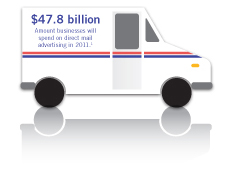 Even if today’s volumes stabilize, removing Saturday delivery obviously increases the amount of mail at the mailbox the other five days of the week, as well as decreases the point-of-response for many households from six to five opportunities per week. To attempt to maintain open rates, direct mail marketers will respond with increasingly creative shapes, colors of carrier envelope/postcard graphics and offers to attract attention.
Even if today’s volumes stabilize, removing Saturday delivery obviously increases the amount of mail at the mailbox the other five days of the week, as well as decreases the point-of-response for many households from six to five opportunities per week. To attempt to maintain open rates, direct mail marketers will respond with increasingly creative shapes, colors of carrier envelope/postcard graphics and offers to attract attention.
Reductions in the Postal Service workforce and facilities add up to longer processing and in-transit times, creating problems for marketers attempting to integrate campaigns across multiple media platforms. Marketers will respond by adjusting what was previously viewed as supportive advertising to include a short-form “call to action” that mirrors the longer-form printed direct mail piece.
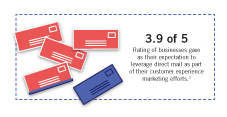 The increased cost of printed direct mail will have a two-fold effect on marketers. First of all, marketers who have, for years, used direct mail as the core of their advertising efforts will evaluate return-on-investment for other direct and indirect tactics. Secondly, for those marketers who choose to keep a direct mail component in their methodologies, all components will come under much closer scrutiny. List quality, or “goodness of list,” will be critical as marketers look to decrease wasted volumes of direct mail, while maintaining response rates. And many of the targeting, propensity-to-respond and testing models that sophisticated direct mailers use today will, in light of the increased costs for shotgun mailing, progress to smaller or less frequent mailers.
The increased cost of printed direct mail will have a two-fold effect on marketers. First of all, marketers who have, for years, used direct mail as the core of their advertising efforts will evaluate return-on-investment for other direct and indirect tactics. Secondly, for those marketers who choose to keep a direct mail component in their methodologies, all components will come under much closer scrutiny. List quality, or “goodness of list,” will be critical as marketers look to decrease wasted volumes of direct mail, while maintaining response rates. And many of the targeting, propensity-to-respond and testing models that sophisticated direct mailers use today will, in light of the increased costs for shotgun mailing, progress to smaller or less frequent mailers.
In short, there are still many reasons that printed direct mail works. Direct response advertisers still find the ability to target at a household- or business-level, the cost per contact and the ease of list acquisition to be an unbeatable combination. As the Postal Service and Congress work through the financial struggles of the Postal Service, marketers need to evaluate other means of outreach and how to reduce waste in their direct mail programs.
December 29th, 2011
Hide your kids, hide your wife.
Economic-bust responses and successful brands.
Anytime I hear someone talk about the current economic situation, I feel like heeding the advice of Antoine Dodson to “Hide your kids, hide your wife!” It’s as if we should all hide under a rock until the economy gets better. With national unemployment at more than nine percent, and one in four homeowners owing more in mortgage than the current value of his or her home, it’s no surprise people are afraid. Fear has certainly translated into fewer and smaller purchases. Even mainstays of Americana, like The Gap, are feeling the buying shift and starting to close stores. Has our economy finally hit the bottom and, if so, what’s next? How can brands succeed during and after the economic bust? What post-bust will look like, no one really knows. Some are still arguing whether or not the bust has even fully hit. But sociology and history can give us some insights.
History and Present Time –
During the Great Depression, people learned to be frugal and trust a small group of brands. They saved every penny, because they didn’t always know when more money would be available. They also still talk about the brands that “lasted” and were “high quality,” even if those brands have become less reliable over time.
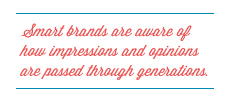 Nowadays, we’ve grown up without needing the same economic survival skills. We’ve been socialized to buy things as needed or wanted, also known as “keeping up with the Joneses.” It’s only very recently that we need to think through purchases differently. But, despite the current economic situation, our socialization encourages people to continue buying new and shiny things, regardless of a lack of funds. So, rather than shelving the idea of purchasing altogether, like during the Great Depression, our population chooses to merely buy an inferior product or postpone the purchase. Question is, while neither of these solutions is necessarily a problem, what does this mean for your business?
Nowadays, we’ve grown up without needing the same economic survival skills. We’ve been socialized to buy things as needed or wanted, also known as “keeping up with the Joneses.” It’s only very recently that we need to think through purchases differently. But, despite the current economic situation, our socialization encourages people to continue buying new and shiny things, regardless of a lack of funds. So, rather than shelving the idea of purchasing altogether, like during the Great Depression, our population chooses to merely buy an inferior product or postpone the purchase. Question is, while neither of these solutions is necessarily a problem, what does this mean for your business?
Future –
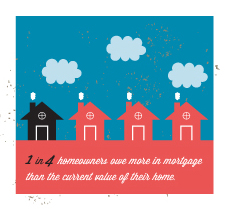 At some point, postponed purchases will turn into actual purchases, but what will spending habits look like? Based on sociology and history, what will most likely happen is people will take what they have recently learned about spending and continue to practice living with less. For example, think about children who have watched their parents struggle with mortgage payments and/or foreclosure. They will probably be the most hesitant to buy a home as an adult. And other purchases will probably take greater consideration. Researchers at the University of Pennsylvania suggest that we will spend where we feel we will get the biggest emotional boost, like a child’s fifth birthday party rather than a new iPhone.
At some point, postponed purchases will turn into actual purchases, but what will spending habits look like? Based on sociology and history, what will most likely happen is people will take what they have recently learned about spending and continue to practice living with less. For example, think about children who have watched their parents struggle with mortgage payments and/or foreclosure. They will probably be the most hesitant to buy a home as an adult. And other purchases will probably take greater consideration. Researchers at the University of Pennsylvania suggest that we will spend where we feel we will get the biggest emotional boost, like a child’s fifth birthday party rather than a new iPhone.
Opportunity –
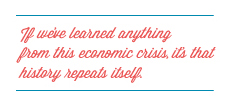 If we’ve learned anything from this economic crisis, it’s that history repeats itself. So, if in the 1930s people trusted a few brands that worked hard to help them during the Great Depression, maybe that is where we can find opportunity today. Brands and campaigns that are focused more on empathy and helping customers, rather than increasing sales, leave a positive impression on people and, therefore, have a better chance at success in the future. A great example is Dunkin’ Donuts. While Starbucks is closing locations, Dunkin’ Donuts is opening doors and encouraging customers with its “You Kin’ Do It” campaign, which speaks directly to “those who keep America running.”
If we’ve learned anything from this economic crisis, it’s that history repeats itself. So, if in the 1930s people trusted a few brands that worked hard to help them during the Great Depression, maybe that is where we can find opportunity today. Brands and campaigns that are focused more on empathy and helping customers, rather than increasing sales, leave a positive impression on people and, therefore, have a better chance at success in the future. A great example is Dunkin’ Donuts. While Starbucks is closing locations, Dunkin’ Donuts is opening doors and encouraging customers with its “You Kin’ Do It” campaign, which speaks directly to “those who keep America running.”
Smart brands are aware of how impressions and opinions are passed through generations, and they are trying to connect in ways that help people and themselves, especially during difficult economic times. Now is the opportunity to eschew hiding under rocks and, instead, become one of the brands remembered for helping people succeed into the future.
December 29th, 2011
Thinking Outside the Toolbox
An article about tools, social media and zombies.
A challenge for many businesses is keeping up with the ever-evolving change between generations. The buying power continues to shift, and, for Westlake Ace Hardware, a chain of local hardware stores that’s primary customer base is baby boomers, the time for a change was inevitable. Problem was, connecting with a younger generation was not so easy for Westlake, as these do-it-yourselfers tend to frequent big box stores (e.g., Lowes, Home Depot) for their hardware needs. So the question became, how does Westlake reach a younger demographic? And furthermore, how does it do so without a huge media budget?
The answer was zombies.
In order to tap into the younger population, Westlake needed to relate with this demographic. And what better way than with zombies? Now, while it would be easy to assume that this seemingly unorthodox idea was simply the product of a booze-filled evening, the thought process behind Westlake’s zombie campaign stemmed from a great deal of research.
At the conception of the zombie campaign, 247WallSt.com estimated the zombie industry to be worth $5.74 billion. Zombie movies surpassed more than $3 billion in the last decade, video games were estimated at $2.5 billion, and Halloween costumes were estimated at more than $500 million. And, fortunately for Westlake, this more-than-just-a-mounting-pop-culture-trend resonated exceptionally well with the campaign’s target demographic. For example, in 2010, the premier of The Walking Dead boasted the highest debut for any 2010 cable series, attracting 3.6 million viewers aged 18 to 49. All research combined, a zombie campaign was a no-brainer.
At this point, zombies were in motion and the next step was to figure out how to implement this campaign in a way that would engage the target audience. To the rescue, as it so often is, was social media.
With 16.6 million “zombie” searches monthly, and zombie-related Facebook fan numbers at an all-time high, research reinforced that zombies and social media would successfully reach the younger target market. So, Westlake launched a full-blown social media campaign.
![]() The campaign unfolded in a three-phase storyline that spread across Facebook, Twitter, YouTube and the company’s website. Phase one kicked off with a zombie-defense product line for humans – a.k.a., the Zombie Preparedness Center. Phase two began with news crews capturing footage of zombies protesting outside of a Westlake location, and it ended with Westlake offering a zombie-friendly product line. During phase three, Westlake became the first company to attain Zombie-Friendly Certification from ZombiesUnite.org, a non-profit fighting for zombie rights. All social media content was supplemented with in-store posters, flyers and buttons, as well as public relations. Zombie Preparedness media kits were distributed to a number of local media outlets, trade publications, national media outlets, larger websites and prominent bloggers. The combination of all this proved successful.
The campaign unfolded in a three-phase storyline that spread across Facebook, Twitter, YouTube and the company’s website. Phase one kicked off with a zombie-defense product line for humans – a.k.a., the Zombie Preparedness Center. Phase two began with news crews capturing footage of zombies protesting outside of a Westlake location, and it ended with Westlake offering a zombie-friendly product line. During phase three, Westlake became the first company to attain Zombie-Friendly Certification from ZombiesUnite.org, a non-profit fighting for zombie rights. All social media content was supplemented with in-store posters, flyers and buttons, as well as public relations. Zombie Preparedness media kits were distributed to a number of local media outlets, trade publications, national media outlets, larger websites and prominent bloggers. The combination of all this proved successful.
From an increase in site visits and Twitter followers to an overwhelming amount of recognition by the media (locally, nationally and internationally), all of the results confirmed one thing: never underestimate the power of social media, public relations and word-of-mouth. Time and time again, it has proven to be a powerful, affordable and undying combination.
December 29th, 2011
DANGER: Clicking Range
Online advertising continues to change targets – from direct-response advertising to branding media.

Today, online marketers continue to grapple with the same question, through the analysis of metrics.
The entire online industry has made itself about click-through rates (CTRs) to justify why you would spend money on online advertising, while the true value of branding has been forgotten.
Up to this point, CTRs and impressions have dominated digital measurement and evaluation, despite mass evidence that proves the importance of building brands. Today, the role of the CTR is shrinking, but is by no means defunct. What we really need to do is look at the wider context – the engagement with consumers across online media.
There have been many conversations taking place lately about relying on CTRs to measure the success of a campaign, but more advertisers are now relying on brand recall and intent-to-purchase metrics to determine the success of a campaign.
For years, advertisers and publishers have been predicting and hoping for the death of the CTR, complaining it’s a highly inefficient way to measure an ad’s success. Industry CTRs are notoriously minuscule, hovering at less than 0.1 percent. The truth of the matter is that the vast majority of people who see online ads do not click on it, but that doesn’t mean the ads aren’t working. In fact, it’s quite the contrary. Customers are responding to the ads, often with purchases made not long after seeing the ad, and often without clicking.
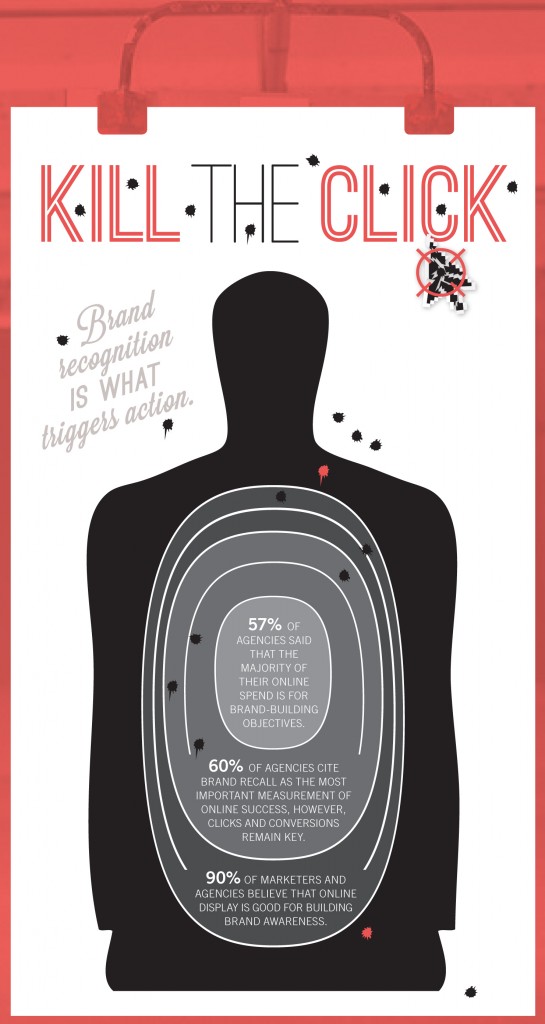 For many campaigns, the branding effect of the ads is what’s really important, and generating clicks is more of an ancillary benefit. Ultimately, judging a campaign’s effectiveness by clicks can be detrimental, because it overlooks the importance of branding.
For many campaigns, the branding effect of the ads is what’s really important, and generating clicks is more of an ancillary benefit. Ultimately, judging a campaign’s effectiveness by clicks can be detrimental, because it overlooks the importance of branding.
When someone interacts with a brand online, it helps nudge them along the path to purchase. While it may not be driving clicks, it is driving results. Rather than clicks, we should be aiming for users to freely engage with our brands and receive a memorable and positive experience in return.
In How Online Advertising Works: Whither The Click?, comScore demonstrates that two-thirds of Internet users do not click on any display ads over the course of a month, and that only 16 percent of Internet users account for 80 percent of all clicks. Furthermore, clickers tend to be younger and less affluent than non-clickers.
Overall, comScore confirmed that there is a latency effect and branding effect to online advertising, in which users arrive at the advertiser’s website, even without clicking. In comScore’s research, which included 139 display campaigns from seven verticals, comScore has shown substantial effects on traffic, sales and branding, despite the lack of clicks. According to comScore, over a four-week period, the display campaigns yielded a 46 percent lift in advertiser website visits. In addition, over a four-week period, exposed users were 38 percent more likely to conduct an advertiser-related, branded keyword search, and are 27 percent more likely to make a purchase online. Furthermore, exposed users were 17 percent more likely to make a purchase at the advertiser’s retail store.
So what’s the moral of this clicking tale? It may be wise to shift your focus from clicks to branding, because online display advertising, even without high click-through-rates, can keep your customers in range and hitting your desired target.




